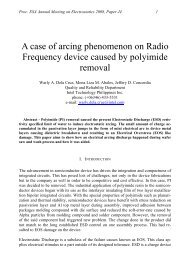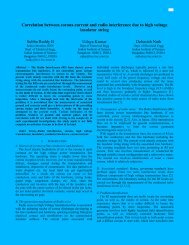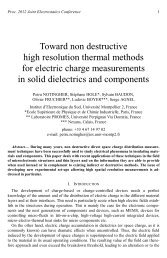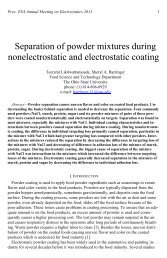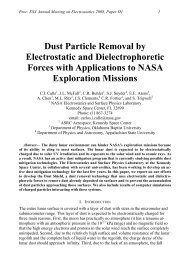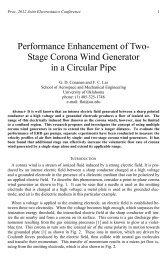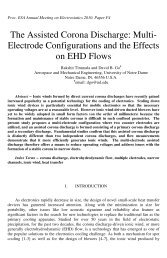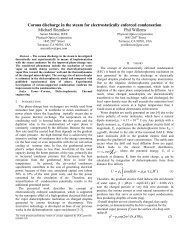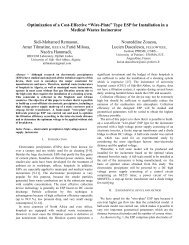Determination of Particle Charge to Mass Ratio Distribution in ...
Determination of Particle Charge to Mass Ratio Distribution in ...
Determination of Particle Charge to Mass Ratio Distribution in ...
Create successful ePaper yourself
Turn your PDF publications into a flip-book with our unique Google optimized e-Paper software.
Proc. ESA Annual Meet<strong>in</strong>g on Electrostatics 2008, Paper G2 8A for each data set, all drops are re processed for all measurement locations, for each dataset <strong>to</strong> f<strong>in</strong>d the mean and standard deviation <strong>of</strong> drop charge as a function <strong>of</strong> size.Follow<strong>in</strong>g this method, it is found that drop charge does not exceed Rayleigh limit fornearly all mean charges. As no explicit limit is imposed dur<strong>in</strong>g post process<strong>in</strong>g, thisconfirms the applicability <strong>of</strong> the proposed method.Processed data show that the values <strong>of</strong> the drop charge are proportional <strong>to</strong> dropletdiameter <strong>to</strong> the power <strong>of</strong> exponent which varies <strong>in</strong> range <strong>of</strong> 2.1 <strong>to</strong> 2.9 for the spray <strong>of</strong>specific charge 1.2C/m 3 . The lower limit <strong>of</strong> this range agrees well with surface areatheory and the upper limit with that <strong>of</strong> the results reported above [14].IV. CONCLUSIONIn this work a brief overview <strong>of</strong> scientific literature that explores measurement techniquesfor determ<strong>in</strong>ation <strong>of</strong> charge <strong>to</strong> mass ratio distribution <strong>in</strong> electrostatic applications ispresented. Important observations and key aspects regard<strong>in</strong>g these techniques are noted.It is shown that the conflict<strong>in</strong>g results exist for the dependence <strong>of</strong> charge <strong>to</strong> mass ratio onparticle size and it is suggested that this area needs further experimental and theoreticalresearch.REFERENCES[1] R. C. Brown, “Tu<strong>to</strong>rial review: Simultaneous measurement <strong>of</strong> particle size and particle charge,” J.Aerosol Sci., vol. 98, pp. 1373–1391, 1997.[2] A. Krupa and A. Jaworek, “A method for aerosol-particle charge measurements,” J. Electrostat., vol. 23,pp. 289–292, 1989.[3] J.R. Greaves and B. Mak<strong>in</strong>, “Measurement <strong>of</strong> the electric charge from aerosol cans” IAS AnnualMeet<strong>in</strong>g, C<strong>in</strong>c<strong>in</strong>nati, pp. 1075-1080., 1980.[4] D. C. Aldred, A. F. Howe and A. Wright, “Size selective particle charge measurement” Filtech Conf.,1983.[5] T.C. Anes<strong>to</strong>s, J.E. Sickles and R.M. Tepper, “<strong>Charge</strong> <strong>to</strong> mass distributions <strong>in</strong> electrostatic sprays,” IEEETrans. Ind. App., Vol.13 Mar./Apr. 1977, No.2, pp. 168-177.[6] Jones A. R., “The production <strong>of</strong> charged monodisperse fuel droplets by electrical dispersion” J. Phys. D:Appl. Phys. Vol. 4, pp. 1159-1166, 1971.[7] K. Tang and A. Gomez, “Generation by electrospray <strong>of</strong> monodisperse water droplets for targeted drugdelivery by <strong>in</strong>halation,” J. Aerosol Sci., pp. 1237–1249, 1994.[8] Q. Ye and J. Domnick, “On the simulation <strong>of</strong> space charge <strong>in</strong> electrostatic powder coat<strong>in</strong>g with a coronaspray gun,” Powder Technology, Vol. 135-136, pp.250-260, 2003[9] M.M. Pauthenier, M. Moreau-Hanot, “La <strong>Charge</strong> des Particules sphériques dans un champ ionize”, J. d’Physique Radium, 7, 590– 613, 1932.[10] A. M. Johns<strong>to</strong>n, “A semi-au<strong>to</strong>matic method for assessment <strong>of</strong> electric charge carried by airborne dust,” J.Aerosol Sci, vol. 14, no. 5, pp. 643–655, 1983.[11] T. Gillespie and G. O. Langstroth, “An <strong>in</strong>strument for determ<strong>in</strong><strong>in</strong>g the electric charge distribution <strong>in</strong>aerosol,” Can. J. Chem., vol. 30, pp. 1056–1068, 1952.[12] Pfeifer R.J., Hendricks C.D., “<strong>Charge</strong>-<strong>to</strong>-mass relationships for electrohydrodynamically sprayed liquiddroplets”, Phys Fluids, vol. 10, pp. 2149–2154, 1967.[13] V. E. Krohn, “Liquid Metal Droplets for Heavy <strong>Particle</strong> Propulsion,” Progr. In Astronautics andRocketry, A. C. N. Y., Vol. 5, 1961.[14] L. de Juan and J. F. de la Mora, “<strong>Charge</strong> and Size <strong>Distribution</strong>s <strong>of</strong> Electrospray Drops,” Journal <strong>of</strong>Colloid and Interface Science, 1997.[15] Chen, A., Bi, H.T. and Grace, J.R., "Measurement <strong>of</strong> particle charge-<strong>to</strong>-mass ratios <strong>in</strong> a gas-solidsfluidized bed by collision probe," Powder Technology, pp.135-181, 2003.[16] M. Orme, J. Courter, Q. Liu, J. Zhu, R. Smith "<strong>Charge</strong>d Molten Metal Droplet Deposition as a DirectWrite Technology," MRS 2000 Spr<strong>in</strong>g Meet<strong>in</strong>g, 2000.




